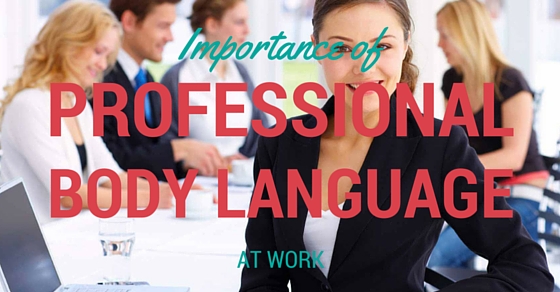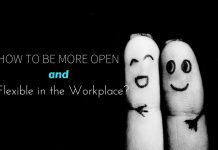‘First impression is the last impression’. This being a very old saying has proved to be a very effective saying since ages. With the vast change in the concept of interviewing a candidate from traditional knowledge and experience based question answers to emotional intelligence proving question answers, the technique of judging the candidate has also changed a lot.
In an interview board nowadays, the candidate is judged in few seconds even before he opens his mouth to answer a question. It is the candidate’s body language which answers all.

Mastering body language tips at workplace can be awfully helpful for any person in gaining him added advantage over others. A common trait in young generation is to get nervous facing the interview board or the boss at his office. They can easily master their body language skills and can, in turn put the other person on his nerves.
Winning over the body language can easily counter their shyness and trembling of voice when they are ought to be smart and confident.
Types of Body Language in Workplace:
The following mentioned are few body gestures and body expressions that explain the perfect importance of body language at work
1. Body Movements & Gestures:
Body language gestures and movements of several body parts like head, hands etc play a key role in conveying messages through body language. Such body languages convey messages which have linguistic translations without a need to speak or write anything. Though the use of different body gestures and movements has different cultural implications in separate countries, still they are widely used for its convenience.
2. Facial expressions & eye contact:
Face is often defined as the mirror of the heart. Your Facial expression though is not technically treated as a part of body language but plays a vital role in communicating your attitude and emotions. Your eye contact or lack of it may convey your attitude without uttering a word.
3. Space:
Proximity is another body language that readily conveys you’re like or dislike towards a person.
4. Touch:
There are functional- professional touch and impersonal soft touch that is used as a body language to communicate non- verbally also.
Good Body Language Tips for Achieving Success in Career:
The following are few positive body language signs that help one to achieve success.
1. Posture:
Your posture should reflect your confidence and that you are self assured. Sit straight with your pelvic bones and neck bones in alignment. This posture makes you look and feel even more professional in your approach.
Posture should be perfect at workplace both while sitting and/or standing. This helps you improve your position among your colleagues and in the eyes of your superior which will surely help your message get more weightage.
2. Eye contact:
Another most important body language is conveyed by the eye contact. An eye contact of more than 50%-60% is positive but anywhere less than 40% registers a lack of interest in the person or in what being said.
When you are registering to some talk being said to you, it is wise to look downwards as it is known to be a polite gesture. Looking below anywhere other than the eye is not acceptable in a professional setting.
3. Body Positioning:
In a professional setup you have to be very careful about how you are dealing with your body positioning. While it is a serious business meeting you should be sitting with shoulder to shoulder facing with your partner as this indicates a position of open communication with no room for confrontation or argument.
You should be very cautious about your standing too, if your legs or arms are crossed which is likely to indicate a feeling of insecurity in you or you are not being able to trust something.
Sitting or standing at eye levels would surely send a message of equality. Standing with holding your hands at your back shows your confidence level.
4. Maintaining formal distance:
Maintaining a proper proximity is always granted as a positive body language in a professional environment. Some people like closeness in communication and getting their messages conveyed while others feel uncomfortable in less distance.
Every culture has different significance of proximity so you should be very careful while using this body language. Maintaining a social distance could be beneficial for you in workplace in gaining confidence of the other person.
Maintaining such a distance where you could not see the other person down but have a healthy voice pitch and good eye contact is more necessary.
5. Use of hands:
Trying to communicate involving your hands adds freshness and meaning to your message. You need to be carefull with the usage of hand gestures as well while communicating as they have different cultural significance across the world.
Make a practice to rehearse in front of the mirror engaging your hands. Hands help a lot in emphasizing an important point in a communication.
6. Low vocal pitch:
A person with a low vocal pitch in a workplace is judged to be more contended, knowledgeable and perceived than one who speaks in a higher pitch. One who has a higher volume is a person with less empathy and is less powerful in his workplace.
Your vocal pitch and proper voice modulation is very important factor in a telephonic conversation where you are judged on your voice.
The success of the communication here depends a lot on how your voice can grasp the person on the other side and convince your point.
7. Use of open gestures:
A person who shows signs of openness is more acceptable and welcomed than a person with closed arms and cross gestures. Showing the palms of your hands with an open to read gesture is sure to add more credibility to your body language skills at work.
Keeping your hands held at your waist level will show you more confident at your point. Showing the palm of your hands may keep you at an advantageous position as it signifies more openness.
8. Smile:
Our brain cells welcome a happy face more than a sad one. For this reason the only smile is one of the most important and most acceptable forms of body language. A smile can make an environment very soothing and free from nervousness.
A greeting with a pleasant smile makes your appearance more approachable and assertive. A smile in today’s world can do wonders from lighting a gloomy mood, to accept a request, boost up self-confidence, crack a deal and also make up a broken relation.
9. Master the art of Handshake:
As touch is one of the most accepted and primitive non-verbal mode of convincing, a good handshake can yield a lot for you. In professional world handshakes do tell about your character, a firm grip makes you more confident while those who are shy will tend to be soft in shaking hands. So mastering the art of a proper handshake can crack a deal for you and on the other hand, a wrong way of giving a handshake can break the deal as well.
Body Language in Workplace – Mistakes to Avoid:
Some of the utter blunders made in workplace result from wrong body languages. Here are listed a few such body languages which you should practice to avoid to minimize the chances of workplace confrontations.
1. Holding objects in front:
This is a sign of shyness or nervousness where you are tending to distract your attention from others making yourself aloof from them. If they are utterly necessary for you then try holding them by your side leaving the front available for a clear and open communication scope.
2. Looking at your watch:
A very common sign to show boredom is looking at the watch time and again. This is also a very insulting gesture mainly when you are talking to your superior. So try to avoid this habit and concentrate on what he/she may be saying.
3. Inspecting fingernails or playing with rings or accessories:
While in a meeting or talking to your superior if you tend to inspect your finger nails repeatedly or biting them or playing with your finger rings or other accessories then it conveys a clear message of disrespecting the person on the other side of the table. By doing this, you may place yourself at the most disadvantageous position in your workplace.
4. Standing too close:
While you are into a professional talk or discussion it is better to maintain a formal distance between both. 4 square feet of space around the body is considered to be the personal space. When you tend to break this space and get closer, then you should keep in mind that the other person may feel uncomfortable and get irritated. This space can only be broken in case of personal or very intimate relations. Crossing this boundary may cause serious issues at workplace.
5. Looking down at the floor:
When you are with others in a group meeting or so, looking down towards the floor or your shoes may reveal your disinterest in the matter which is being discussed. This body language tends to insult the superior present at that moment. Avoiding this helps to maintain good work culture with others.
6. Giving a fake smile:
As a real smile can make a deal or make a mood, a fake smile can fail the show. When the smile is not from the heart and fake it will surely fail your other efforts to make the show. A genuine smile is reflected in the eyes while a fake one is like elastic which goes back in seconds.
7. Arms crossed:
In order to defend ourselves we tend to guard our chest with our arms. Thus a posture with arms crossed is a defensive pose which can reveal a sign of resistance and egotism which is very repulsive in a professional setting.
8. Scratching your head:
Scratching your head is a sign of low confidence and puzzled or lack of knowledge. You may also end up with creating an impression of lying if you keep on scratching the back of your head. So avoiding such a gesture will be beneficial for you.
9. Wiping hands on your clothes:
Even if you are tensed and feeling nervous with sweaty hands leave them like that because continuously rubbing them on your clothes will land you in making an impression of awfully nervous in dreaded situations which no company would prefer in a matured employee.
11. No eye contact:
As we all know eye contact is a very bold point in body language, avoiding a eye contact may imply deception. So trying to maintain a firm eye contact will reveal your confidence level.
12. Bad handshake:
A cold handshake with no grip, no locking of thumbs, no palm to palm contact is sure to break the deal as you would be portrayed as very low at your confidence level.
13. Keeping your phone out:
Keeping out your phone on the table while having a conversation creates a feeling that you are trying to neglect the other person. It can bring a feeling that the phone is more important than the person talking and it’s better to have a conversation over the phone. This is a gesture of sheer insulting which should be avoided in a workplace.
14. Eye Rolling:
Rolling your eyes while talking with a superior may even cost you the job, as researchers have found this gesture as a very dangerous one in most cases. This gesture reveals a kind of very casual, giving no respect or no appreciation to what they are saying. This can be worked out with a self awareness.
Right body language at the right place is as influential as other verbal forms of communications. Proper body language gives you a key to real success. Positive body language can help you crack difficult deals, build business relationships, influence others, develop bonding with co-workers, and motivate subordinates at workplace, connect you with effective personalities, mark your presence in the crowd, establish and approve your point in a meeting, prevent conflicts at workplace and in overall, open up a world of opportunities in front of you.











































